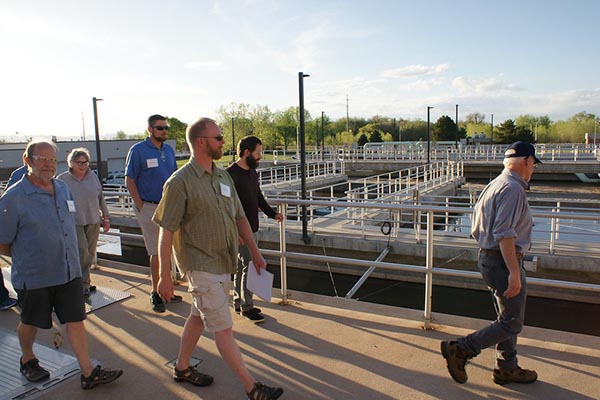Water Reclamation FAQs and Tours#
Request a Tour#
Go behind the scenes of Utilities’ water reclamation facilities and learn about the intricate processes used to treat our wastewater from expert tour guides.
FAQs#
-
Wastewater is the used water (and anything else) that goes down the drain or toilet in businesses, restaurants, industries and residences within the Fort Collins Wastewater Collection System.
-
The water reclamation plants treat customers’ wastewater for sediments, suspended solids, nutrients and pathogens, using a variety of chemical, physical and biological treatment processes. The treatment of these pollutants keeps the water that is discharged into the Cache la Poudre River and Fossil Creek Irrigation Ditch safe for the ecosystem, including aquatic life. The treatment also keeps our water safe for recreation, in addition to ensuring safety for water users downstream on the Poudre River. For more details on the treatment process, visit the Drake or Mulberry facility pages.
-
Water from the Fort Collins collection system comes to our facility where bar screens and grit removal systems to remove solids, trash or other objects to be sent to a landfill. Next, most of the suspended solids are settled to the bottom or surface of the water and removed. Then, we use a variety of phosphorus-accumulating organisms to help remove nitrogen and phosphorus from the water, preventing eutrophication in downstream water. Finally, the water is disinfected using UV lights to treat the water for harmful pathogens. For more details on the treatment process, visit the Drake or Mulberry facility pages.
-
Sludge is somewhat of a broad term used throughout the treatment process. It mostly refers to the organic solids that are used in and treated in the overall process. For example, we use the term “activated sludge” to describe the semi-solid suspension of biomass that is used in the biological section of our treatment process for phosphorus and nitrogen removal. This sludge is recycled through this section of the process a few times until it is spent and considered “waste activated sludge”, or WAS. This WAS is sent to sludge thickening and further treatment so that it may be turned into biosolids, which may be applied as a beneficial land amendment. Another source of “sludge” in our treatment process is from the clarifiers which settle out scum. This is also sent to treatment for biosolid production. For more details on the treatment process, visit the Drake or Mulberry facility pages.
-
We have a team of certified operators to operate the facilities and monitor water quality parameters throughout the treatment process. Our Drake facility is highly automated but still requires consistent oversight by operators. Our Mulberry facility is even more highly automated.
-
The challenges of treating the water often depend on the pollutants we see. A source of these pollutants can be different spills or accidents in industry where some pollutant is discharged, which we must respond and adapt to.
There are also pollutants of emerging concern that we have begun to see more of including PFAS, personal care products, pharmaceuticals and more, which have damaging effects on aquatic life and human health. New pollutants appear all the time, so we have to be prompt in responding to the changing water quality and regulations.
As regulations change, we must adjust our processes to remain compliant with federal, state and local rules and regulations, which can be expensive and time consuming. For example, new regulations have recently emerged regarding phosphorus discharge; we have had to plan ahead to ensure that we are well below the future discharge limits for phosphorus.
Another challenge we face is how drastically water quality can change in the event of a natural disaster, such as a flood or a fire. We have to have emergency preparedness plans in place to ensure that we are able to respond to these events quickly, cohesively and efficiently.
-
There are a significant amount of pollutants that complicate our processes, can damage the facility or collection system, adversely affect the health of our operators, and even damage the environment downstream. People can help minimize the number of contaminants that so frequently go down the drain. Only flush the three Ps: pee, poo and toilet paper.
Here is a list of items never to flush or wash down the drain. Not flushing these items can also help prevent sewer backups in your home.
- Wipes (even flushable)
- Menstrual products
- Pharmaceuticals
- Condoms
- Microplastics (tiny plastic beads found in shower products for exfoliation)
- Paper towels
- Cotton balls
- Cotton swabs
- Dental floss
- Trash
- Cigarette butts
- Hair
- Phosphate-containing detergents
- Fats, oils, and greases (FOG)
-
Treated water is discharged into the Cache la Poudre River and Fossil Creek Irrigation Ditch.
-
We use an innovative technology called biofiltration, which takes the gas byproducts from our process and immobilize the odor-causing microorganisms to improve the smell.
-
To apply for a business or industrial permit, click here. Follow the page to your specific business need or contact our Industrial Pretreatment Senior Supervisor, Allison Becker at (970) 221-6927 for further information.
Did You Know?
Epic Homes offers $60 home energy assessments that can find ways to reduce utility costs and increase comfort.
Using a microwave oven for warming, reheating or cooking food uses less energy than an electric oven.
Fertilizer encourages grass to grow, requiring more water. Use it lightly.
